Turkish Delight or Lokum as it’s known in Turkey is a delicately flavored jelly candy, perfect for serving any time of year. This recipe is scented with rosewater but you can use cinnamon, orange, vanilla or bergamot instead.
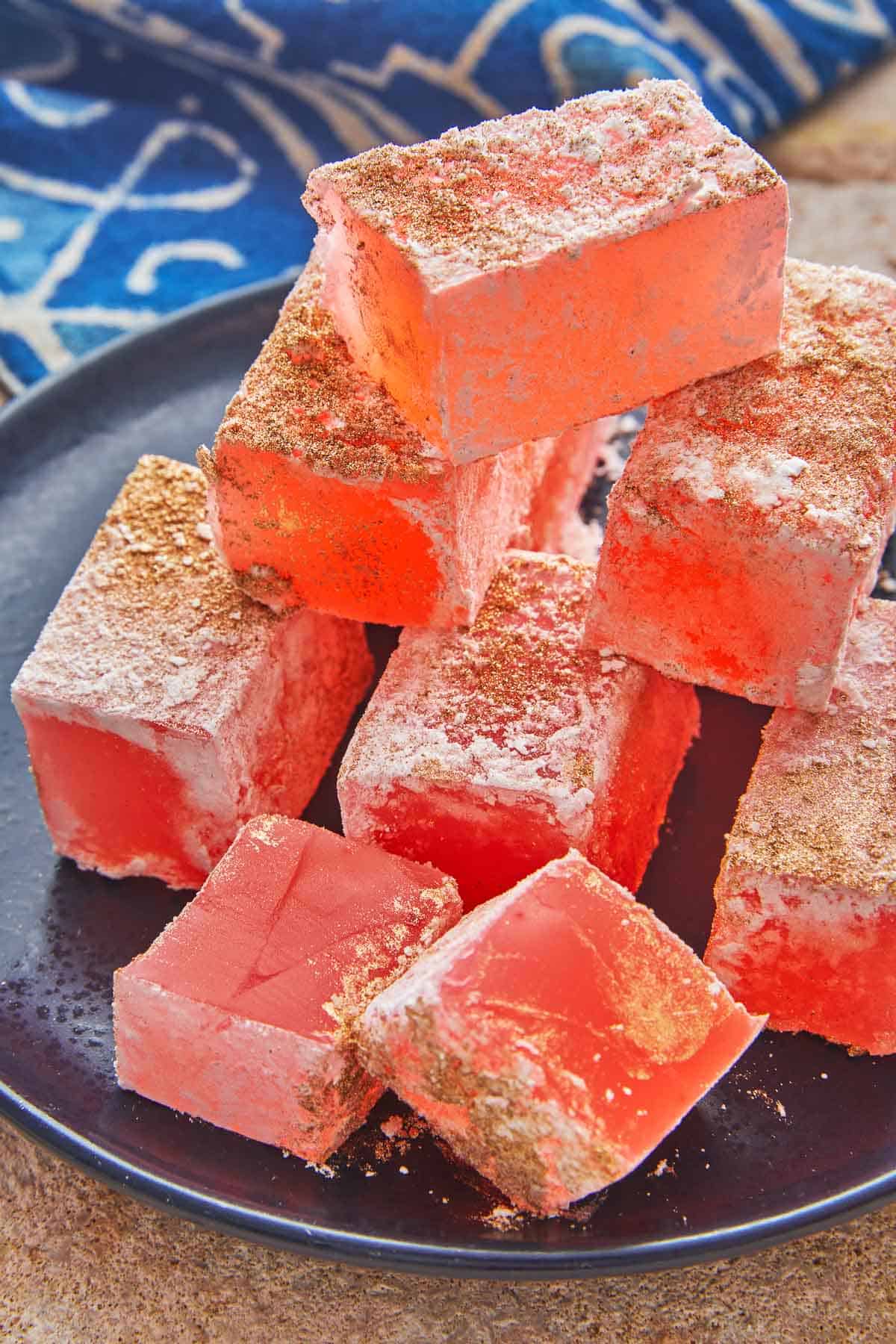
Turkish Delight, also known as Lokum, is a delicately flavored, fragrant, chewy jelly candy that has been a hallmark of my homeland, Turkey, since Ottoman times. It’s one of my absolute favorite recipes and I’m happy to share it with you.
The texture of Turkish delights is somewhere between a jelly candy and marshmallow. You can flavor it in any number of ways. In this recipe I use rosewater, which has a delicate floral note to it. You can find our favorite rosewater at our shop, or check the international aisle of your grocery store.
If you’re new to rosewater, you can learn all about it, how to cook with it, our favorite type, and how it’s made in our “What Is Rose Water And How Do You Use It” essential guide. Start with a light hand — too much can taste soapy. If you don’t like rosewater go ahead and replace it with your favorite extract or dried fruit.
Make this sweet, bite-sized candy and add it to your holiday dessert tray along with Egyptian Butter Cookies, Italian Biscotti, Candied Orange Peels, and Kuru Kayısı Tatlısı (Turkish Poached Apricots With Ricotta) for a celebration of international flavors.
“Afiyet Olsun,” as we say in Turkish, which means “May you be happy and healthy with this food.” I hope you enjoy making this lokum recipe in your home as much as I do in mine.

Table of Contents
What is Turkish Delight?
Turkish Delight or Turkish Delights also called Lokum are a fragrant jelly candy recipe native to Turkey. I make these delicate candies in a variety of ways including with rosewater, bergamot, cinnamon or orange and sometimes include coconut, dried fruits and nuts. Throughout Turkey they come in different colors, textures and flavor combinations.
Throughout Turkey, these delicate candies are shared to close a meal with coffee, placed on dessert trays for holidays, weddings and other special occasions. Basically, people enjoy them whenever they can all year long!
History and Origins of Turkish Delight
Lokum is an important part of the Ottoman cuisine culture, adapted by many Middle Eastern and Balkan countries, with variations.
The Turkish name Lokum is derived from the Arabic word luqma, meaning mouthful, morsel. Originally called “rahatu’l – hulkum,” rahat meaning ‘with ease,’ as the lokum comforted the throat and was easily swallowed. Eventually people called the candy “rahat lokum” and then simply “lokum.”
The name wasn’t the only thing that changed. Originally, the Ottomans made a crude version of Turkish delight using honey or molasses. However, once refined sugar arrived in the late 18th century it slowly took over as the sweetening agent of choice.
Haci Bekir, a well-known confectioner, became famous due to his ingenious use of white sugar and cornstarch. He was summoned to the Topkapi Palace to pioneer the development of what is today one of Turkey’s hallmark confections.
Later on, rosewater and mastic, the resin of a tree used in many desserts from ice cream to commercially made Turkish delights, were also added to create more aromatic, chewier versions of the candy.

What is in Turkish Delight
- Powdered sugar: This ingredient serves two purposes: to sweeten and to help prevent the cut pieces from sticking together.
- Cornstarch: This is mixed with the powdered sugar to absorb moisture to prevent sticking and added to the hot sugar mixture to help bind the candy.
- Superfine (Baker’s sugar): Superfine sugar is just smaller granules of granulated sugar, and if you can’t find it, it’s easy to make at home. Add granulated sugar to a food processor and pulse for about 30 seconds or so. Plain granulated sugar will also work; the candy will be a little less sweet.
- Lemon: The juice of the lemon is to add flavor and to help prevent the sugars from crystalizing.
- Gelatin: Acts as a binding agent. Without it the Turkish delight wouldn’t hold its shape.
- Rosewater: I love rosewater, but if you’re new to the flavor you might want to start with half the amount used in this recipe. Or you can use whatever your favorite extract is.
- Food coloring: This is optional and you can use it if you want a pink hue. You can skip it all together or use a little pomegranate juice to color it.
- Edible glitter: It’s just a little something special. You don’t need it.
How to Make Turkish Delight
Making a successful batch of Turkish delight depends upon the timing of a few ingredients and a candy thermometer.
Prepare the baking dish: Turkish Delight is sticky. Lining your baking dish with parchment is essential for success.
Make the dusting mixture: Combine the powdered sugar and cornstarch. A portion will be used to dust over the candy once it is set to prevent sticking.
Make the sugar syrup: Combine the superfine sugar, lemon juice and 1 ¾ cups water into saucepan and set over medium low heat until the sugar is dissolved.
Make the candy: In a small bowl, combine ½ cup plus 2 tablespoons cornstarch with ½ cup cold water. Whisk into hot sugar syrup. Sprinkle the gelatin over the sugar syrup and whisk to break up any lumps. Bring to a boil (you want the liquid to reach 250°F with a candy thermometer). Simmer over a medium heat for 20 minutes, whisking often. The mixture is ready when it thickens and turns pale yellow – like a soft jelly that is just about set.
Flavor and set the candy: Remove from the heat and set aside for 5 minutes. Stir in the rose water and 1 to 2 drops of red food coloring. (If using chopped nuts, stir them in now.) Pour the mixture into the prepared dish. Leave it in a cool place on your countertop overnight. Ten to 12 hours is ideal, but if you’d like it to set even more you can leave it for up to 24 hours.
Cut the Turkish delight: Dust a cutting board with some of the reserved dusting mixture and transfer the candy to the prepared cutting board. Use a sharp knife or a bench scraper to cut straight down through the candy. Do not drag the knife to cut into cubes. Once cut, coat each cube in the dusting mixture.
Decorate with glitter: If using, go ahead and sprinkle the edible glitter over the Turkish delight.
Dry: Line a baking sheet with parchment paper. Place the Turkish delight cubes in a single on the tray with a little space between each cube. Sprinkle the remaining cornstarch mixture over the candy and leave it uncovered on your countertop for 24 hours. The texture is somewhat between a homemade marshmallow and soft jelly.
Enjoy and store: Turkish delight keeps well stored in a dry place for up to 1 month. Layer the candy between sheets of parchment in an airtight container on your countertop in a cool, dry place away from light and heat. Make sure there is a little space between each piece of Turkish delight.
Varieties of Turkish Delight
Rosewater is one of the most common flavors of Turkish delights but there are endless variations. Once you start making it at home there is little doubt you will come up with a few of your own.
Today, many varieties of Turkish delight are available in Turkey, including:
- mint
- orange
- lemon
- bergamot
- cinnamon
- orange blossom water
Nuts are also common. When using nuts you only need to add about 2 ounces or about a ½ cup of nuts. Make sure you chop them before adding to the candy.
- pistachios
- walnuts
- hazelnuts
- almonds
Tips for Making Turkish Delights
Making candy is both an art and a science. Follow the tips below for a successful candy making experience every time.
- Unless you’re an expert candy maker then a candy thermometer is helpful to get to the proper hard ball sugar stage (250°F) for setting this candy.
- If it hasn’t set, allow another 8 hours or if possible another day to set; as humidity, coolness of the room may impact drying time. .
- Homemade Turkish delight is softer than the commercially available ones, as there are no preservatives in them.
- Let the Turkish delight air dry for 24 hours after cutting it. This will prevent homemade Turkish delight from sweating.
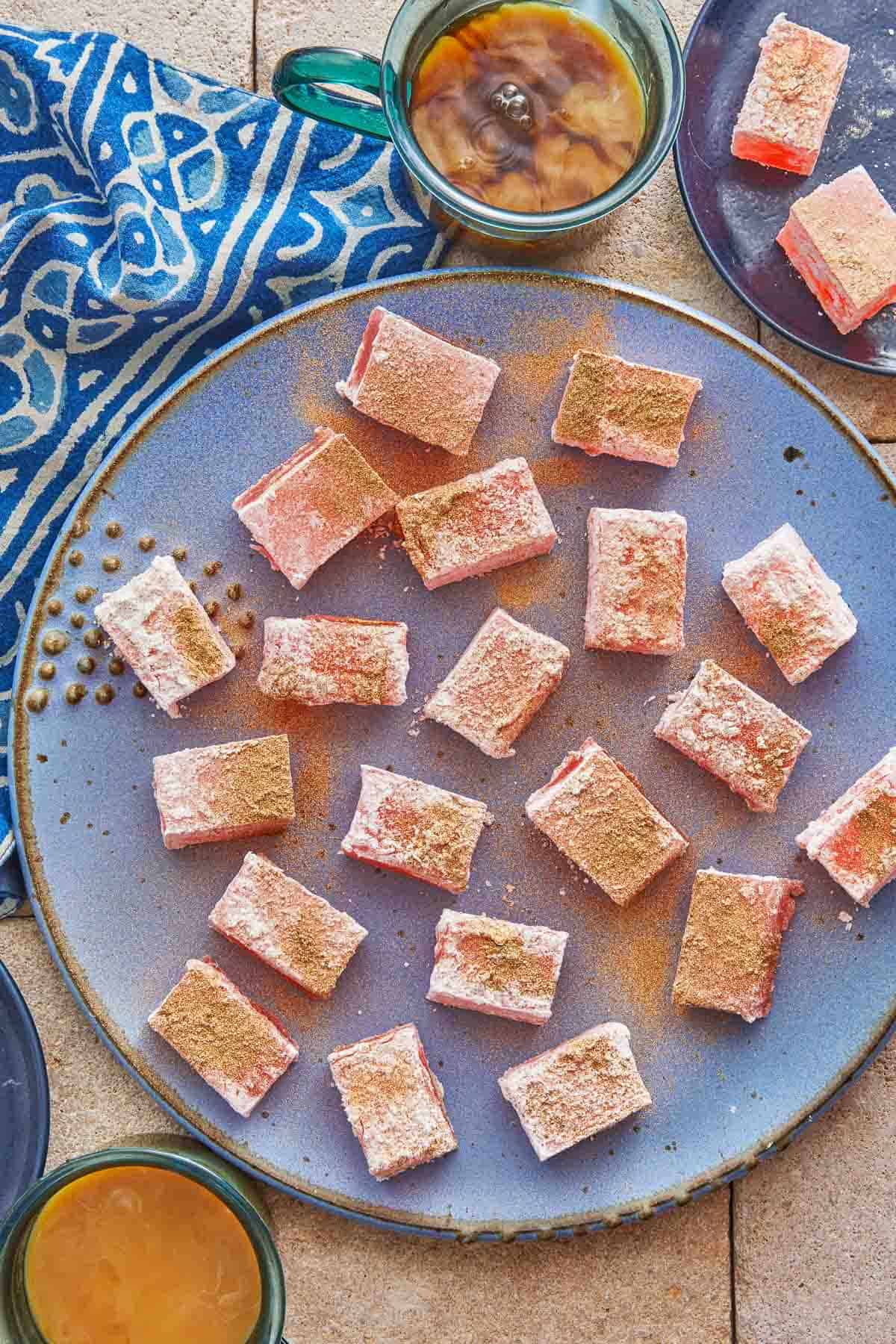
How to Store Turkish Delights
Store Turkish delight in an airtight glass or metal container at room temperature a cupboard or pantry away from heat and sunlight is perfect. They will keep for up to 1 month.
Do not store Turkish delight in the fridge, as the fridge would make it sweat, drawing more moisture out of the candy.
Perfect for Gift Giving
These sweet treats make lovely gifts during the holiday season. To pack Turkish delights as gifts, sprinkle a little cornstarch mixture into a paper bag to stop the sweets from sticking. Feel free to add some edible glitter for a festive touch. Seal up the bag and share with friends and family near and far.
More Sweet Treats
Browse all Mediterranean recipes.
Visit Our Shop.
The Mediterranean Dish Cookbook
The Mediterranean Dish Cookbook: 120 Bold and Healthy Recipes You’ll Make on Repeat. In her book, Suzy brings cross-culturally inspired dishes from throughout the Mediterranean to you, using easy-to-find ingredients and easy-to-follow, to make your meals more vibrant, delicious, and yes — even a little healthier, too!
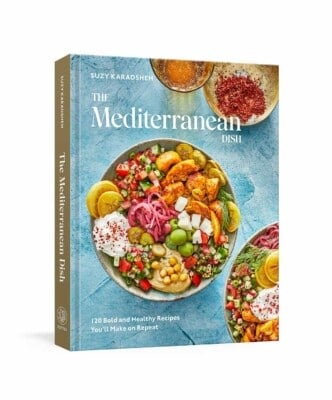
Turkish Delight (Lokum)
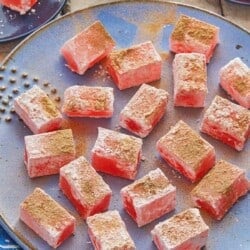
Ingredients
For dusting and coating:
- 3 1/2 tablespoons powdered sugar
- 3 1/2 tablespoons cornstarch
For the Turkish delight:
- 3 cups superfine or baker’s sugar
- 1 3/4 cups cold water
- 1 medium lemon, juiced
- 1/2 cup cold water
- 1/2 cup + 2 tablespoons cornstarch
- 4 3/4 tablespoons powdered gelatin
- 1 1/2 teaspoons rose water
- 1 to 2 drops red food coloring, optional
- Gold edible glitter, optional
Instructions
- Prepare the baking dish: Line an 8 x 8-inch square baking dish with plastic wrap or parchment paper.
- Make the dusting mixture: Into a small bowl, combine 3 ½ tablespoons powdered sugar and 3 ½ tablespoons cornstarch. Sprinkle about 2 teaspoons of this mixture over the base and sides of the baking dish. Set the remaining dusting mixture aside.
- Make the sugar syrup: Into a large saucepan set over medium-low heat, add the superfine sugar, lemon juice and 1 ¾ cups water. Heat gently until the sugar is completely dissolved – do not boil or even simmer.
- In a small bowl, combine ½ cup plus 2 tablespoons cornstarch with ½ cup cold water. Whisk into sugar syrup. Sprinkle the gelatin over the sugar syrup and whisk to break up any lumps. Bring to a boil (you want the liquid to reach 250°F with a candy thermometer), then simmer over a medium heat for 20 minutes, whisking often. The mixture is ready when it thickens and turns pale yellow – like a soft jelly that is just about set.
- Flavor and set the candy: Remove from the heat and set aside for 5 minutes. Stir in the rose water and 1 to 2 drops of red food coloring. (If using chopped nuts, stir them in now.) Pour the mixture into the prepared dish.
- Leave it to set up in a cool place on your countertop overnight. Ten to 12 hours is ideal, but if you’d like it to set even more you can leave it for up to 24 hours.
- Cut the Turkish delight: Dust a cutting board with some of the reserved dusting mixture, and then invert the Turkish delight onto it. Remove the dish; peel off the parchment. Use a long sharp knife or a bench scraper to cut straight down from top to bottom. Do not drag the knife through the candy to cut into cubes. Once cut, roll each cube gently in the dusting mixture to coat.
- Decorate with glitter: If using, go ahead and sprinkle the edible glitter over the Turkish delight.
- Dry the Turkish delight: Line a baking sheet with parchment paper. Place the Turkish delight cubes in a single on the tray with a little space between each cube. Let the Turkish delight air dry for 24 hours to prevent homemade Turkish delight from sweating. Sprinkle the remaining cornstarch mixture over the candy to gently coat each piece and leave it uncovered on your countertop. Once it’s dried for 24 hours Turkish delight is ready to eat. The texture is somewhat between a homemade marshmallow and soft jelly.
- Enjoy and store: Homemade Turkish delight is best enjoyed when fresh, though it keeps well stored in a dry place for up to 1 month. Layer the candy between sheets of parchment in an airtight container on your countertop in a cool, dry place away from light and heat. Make sure there is a little space between each piece of Turkish delight.
Video
Notes
- Use a candy thermometer. It’s best to use a thermometer when making candy to get the sugar to the correct temperature. In this case we are going for a hardball stage which is 250°F.
- Nuts: Feel free to add nuts — pistachio and rose are a classic combination. You only need about 2 ounces of nuts for this recipe or a 1/2 cup, chopped.
- Store: Turkish delight will keep for up to 1 month.
- Visit our shop to browse quality Mediterranean ingredients including olive oils, spices, and more.
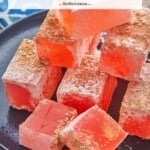


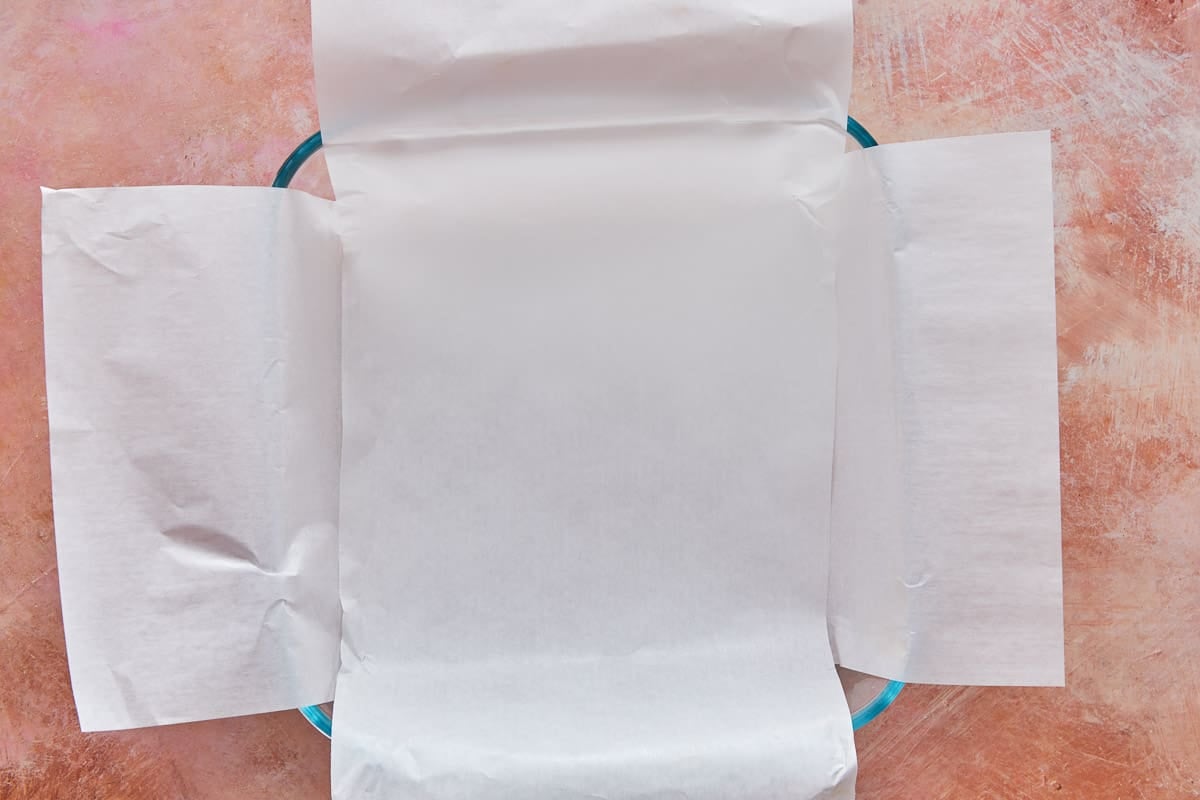


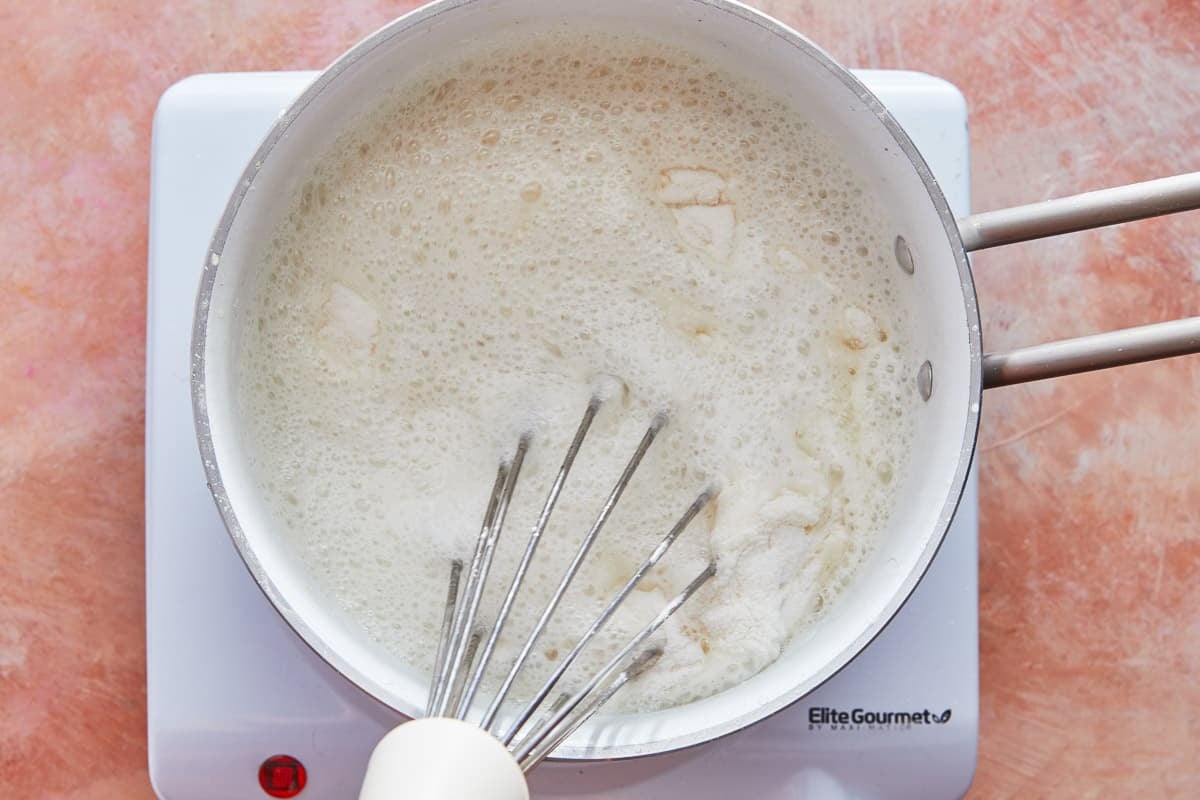

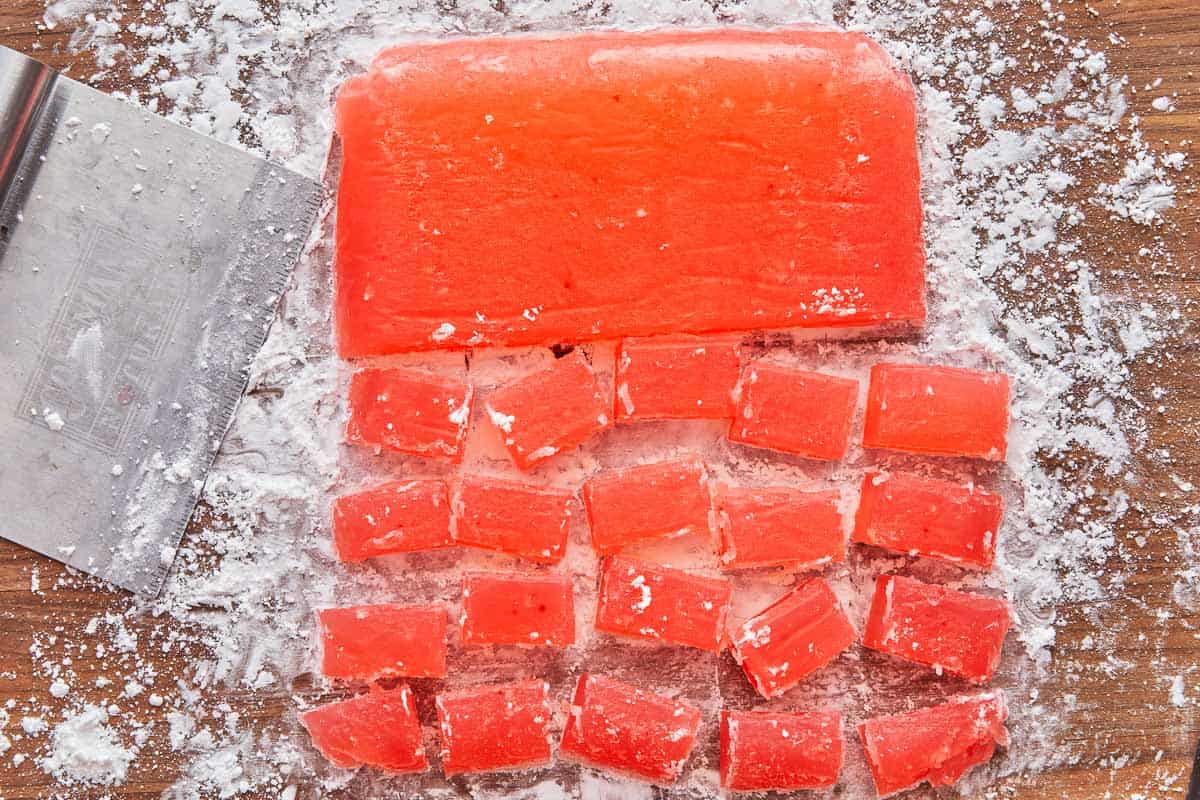


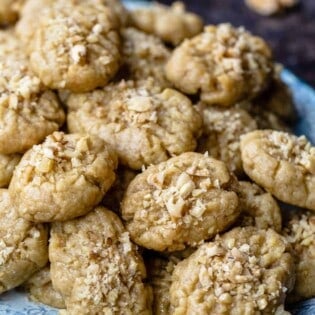


Gummy food!
My daughter and I made your Turkish Delight recipe, and it really is wonderful! The only issue we had was our candy thermometer wouldn’t heat past 225 degrees, so your detailed description of what the consistency of the candy would be was very helpful. We added a touch of red food coloring and some chopped pistachios. This recipe easily gets five stars! Beautiful and delicious!
Love this! Thanks so much, Meredith!
what is the metric measurement for Turkish delight.
I’m looking forward for your answer.
the best,
Nahid
Hi, Nahid. Unfortunately we don’t have metric measurements available for our Turkish Delight recipe at the moment.
Hi what is your metric measurement for turkish delight?
Hi, Nahid. Unfortunately we don’t have metric measurements available for our Turkish Delight recipe at the moment.
I live in a humid area, do you have any recommendations on how to air dry the candies? It’s cold in my area but still rainy and the humidity stays around 70% year-round, I think my home is typically 40-50%
Hi, Scotty! That is a tough question. About the only piece of advice we have seen when researching this is to turn up the air conditioning in your kitchen as you make it to ensure that the air is drier. Best of luck! If you give the recipe a try, please stop back and share your thoughts!
I’m just back from a fabulous trip to Turkey….absolutely amazing! At the Istanbul Spice Market the shops were wall-to-wall with Turkish Delights. A particularly delicious variety were about 1.5″ diameter, 6″ long rolls with some sort of cream (hazelnut cream?) and nuts. The cream was contained in a white edible wrapper and rolled in nuts. They were divine! I can find them at on-line bazaars where they are called Turkish Delights, but they are very, very different from the recipe above. Do you have a recipe for this variety?
Hi, Lena. We don’t at the moment. I’m so sorry. Sounds like something we definitely need to look into!!
this recipe did not work for me, but i am pretty confident that it was user error when it comes to properly comprehending the candy thermometer and other cues. It tasted nice but the texture was very wrong, too chewy, almost like a taffy. i think ill try again when im up for it, but for now ill just say this: do NOT underestimate candy-making.
I made mine without a candy thermometer. I brought it to a hard boil then reduced the heat to simmer. When it looked a little runnier than jelly I took it off the heat. I also forgot to put the gelatin in at the right time and ended up adding after the 5 minute cool down and cooled it in the fridge for a few hours before putting it out on the counter. Did the cut and first dusting 9 hours later. Dusted the second time 18 hours later. It came out perfect.
I tried this recipe and while the finished candy is tasty it is way too chewy. My candy thermometer never reached 250 and the mix was getting so thick and dark yellow it had to be done. Seemed like an awful lot of gelatin perhaps it is supposed to be teaspoons?
I have tried this recipe several times and cannot heat the mixture above 200 without it burning! I am experienced in candy making and find it strange that this recipe uses both cornstarch and gelatin, and on top of that still heats to hard ball stage. I am guessing this is to speed up the process? (Other recipes I have used take much longer to cook, at a much lower heat.) I thought this recipe would save time but hours of trying and nothing but wasted ingredients and tons of sticky dishes to show for it. Can’t speak to the flavour profile as every batch burned.
I am looking forward to trying this recipe as is soon. Also curious about
using fruit juices to vary the flavors – apricot perhaps?
And for the bergamot flavor, do you have a source for bergamot extract or oil?
I’ve tried a couple other TD recipes that didn’t quite work, so looking forward to
trying your version. Love your recipes.
Hi, Julia. Yes, you can definitely use fruit juices to vary the flavors of your Turkish delight. We haven’t tested any with this particular recipes with other juices, so you may have to experiment a bit to get the perfect ratios. Hope the recipe works well for you!
Hello, I would like to ask if it is okay to replace lemon juice with citric acid or cream of tartar because I do not want to have a lemon flavour in my turkish delight? Secondly, does cooking half a portion means cooking it for 10 mins instead of 20? as well as cooking twice or thrice a portion and so on.
I tried making this but I could not get the mixture up to 250 degrees it ended up burnt and I had to throw it away. I used a dark non-stick pot could that have been the problem?
Hi, Lana. I don’t think the type of pan would matter here. Next time, you may want to try heating it just a little less, maybe 240°, and see if that helps.
I had the same issue
Hi, and Merry Christmas…
I printed this Jelly LOKUM twice and I could not get it to print the PICTURE!!!
Can you help?
thanks
Phyllis
Hi, Phyllis. Unfortunately we lost that functionality during a recent website redesign and aren’t able to get it back. I’m so sorry for the inconvenience.
I loved how my TD turned out. Thankyou for your recipe.
I made TD every week for nearly 20yrs tried a few over the years, but my customers always said go back to what they called my recipes. I kinda wish I still had my market stall because I think they would love your version,yours has a lovelly texture, I think it’s the cornflour slurryyou add.
I have had cinnamon, never had Bergamot, love the sound of it though. Thankyou for sharing your recipe with us…💜⭐️
So glad you enjoyed it, Lindi!
Can these be wrapped like caramels – Thanx
Hi, Kathleen. That might work, but it’s not something we’ve tried before.
Hi Suzy,
I’m an avid follower of yours and pin your recipes all of the time. I used to love Turkish delight but have become diabetic fairly recently. Do you think it’s possible to make it using a sugar substitute like monk fruit? Don’t worry if you don’t know the answer, it’s not one a person thinks about unless they have the problem. 🙂
Hi, June. That is a great question! Unfortunately, we don’t have a good answer for you, as it isn’t something we’ve tried before. If you give it a go, please stop back and share your feedback. I’m sure there are others that are curious about this, as well.
Maybe You can also try Stevia.